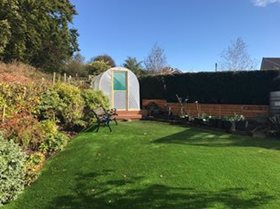Whether you’ve just moved into a new property or have been putting off overhauling your overgrown garden, the landscape you choose could help you get the best from your outdoor space.
Want to know how to design a garden layout? In this guide, we’ve broken the process down into three easy-to-manage stages to help you create a whole new outdoor space!
How to Design a Garden Layout
 As an amateur gardener, it may be hard to feel inspired when looking at a blank space. To help you better visualise and create a garden you can be proud of, consider drawing a landscape plan. This method is quick and easy: simply take a photo of your garden, print and draw your new plan over the top.
As an amateur gardener, it may be hard to feel inspired when looking at a blank space. To help you better visualise and create a garden you can be proud of, consider drawing a landscape plan. This method is quick and easy: simply take a photo of your garden, print and draw your new plan over the top.
Alternatively, if you’re unsure how to design a garden, creating a mood board can be an ideal starting point. From materials and layouts to furniture and colours, this could help to provide the inspiration you need to transform your outdoor space.
Another effective technique is to create a wish list. By considering all the individual elements you would like in your garden, such as a polytunnel for your vegetable patch, you can then use this as a checklist and start to filter these features into your overall design.
Floors, Boundaries and Finishes
When planning your garden layout, it helps to divide it into three crucial areas: the garden floor, the boundary and the finishing touches – for example, furniture and accessories. Because designing an entirely new garden can be a daunting project, this will help to break it up into more manageable chunks, allowing you to focus on each area in turn.
Garden Floor Layout
 As the most important part of a garden redesign, the floor is the heart of your outdoor space. The layout and landscape you choose will determine how functional your garden is, so take your time when planning.
As the most important part of a garden redesign, the floor is the heart of your outdoor space. The layout and landscape you choose will determine how functional your garden is, so take your time when planning.
Consider how you would like to use the space and the ways in which you could divide the area. For example, if you enjoy entertaining, eating al fresco or hosting outdoor family get togethers, incorporating a separate seating area could be a key element. Installing decking or a patio could help you create a separate zone, while paths, archways and raised beds can be used to section and divide.
There are many simple and effective ways to alter layout, such as a circular shaped lawn and path, using symmetry to create an aesthetically pleasing design, or choosing a central focal point such as a water feature to draw the eye.
Updating the Boundaries
When designing a new garden, you may focus on the layout of the floor but it’s crucial to update the boundaries too. This is particularly true in small gardens or backyards where floor space is limited.
Adding design elements to the boundaries, whether a fence, wall or hedge, can enhance the overall finish and feel. This may include creating a vertical garden by using a fence panel to grow herbs, or introducing a tiered planting section by building a staggered outer wall.
Adding the Finishing Touches
 Just like your home’s interior, the final touches can enhance the overall design and layout. By selecting the right accessories, you can transform your garden, turning it from an outdoor space into a relaxing retreat or entertainment area.
Just like your home’s interior, the final touches can enhance the overall design and layout. By selecting the right accessories, you can transform your garden, turning it from an outdoor space into a relaxing retreat or entertainment area.
This is where you can have some fun and let your personality come out. From picking an outdoor furniture set and soft furnishings to selecting different varieties of plants and choosing a colour palette, these elements can bring all your hard work together and complete your garden redesign.
Transform Your Garden or Yard
From the smallest of city-centre backyards to sprawling family gardens, these tips can help you design a layout for a garden of any shape or size. Additionally, for further inspiration, read this RHS guide for style and inspiration tips.